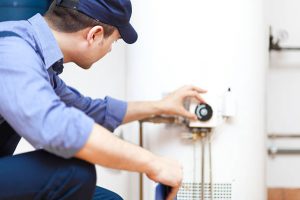Did you know that your home’s water heater is one of the biggest energy consumers when it comes to appliances? However, it’s an important part of your home’s plumbing system. Your water heater ensures that you have hot water for showers, washing dishes, washing clothes, and more. It’s definitely not something you can live without, but there is a way to dial back on its expense – adjusting the temperature.
But before you start turning down the temperature of your water heater, you have to take a few things into consideration. It’s not quite as simple as just turning a knob; if you turn the water temperature too high, you could scald yourself. Conversely, if you turn the temperature too low, dangerous bacteria will start to breed in your water heater tank. Here are the guidelines for how to adjust water heater temps:
You should never go higher than 140 degrees. In fact, 140 degrees may be too hot – a five-second exposure to skin at 140 degrees can give you a third-degree burn. You have to be especially careful if you have children or elderly people with thinner, more sensitive skin in your home.
- If you’re worried about your water being too hot, consider having an anti-scald valve installed. This special valve will ensure that while your water may be 140 degrees as it leaves your heater, it’s never hotter than 120 degrees at the tap. You may be able to tackle installing an anti-scald valve DIY style, but it can be tricky – it’s in your best interest to contact a qualified plumber to do the job.
Related: Is It Time To Flush Your Tankless Water Heater?
You should never go lower than 120 degrees. This is the lowest temperature recommended by the U.S. Department of Energy. Below 120 degrees, harmful bacteria and pathogens can start to breed inside the water heater tank. 120 should be the absolute minimum and if you have family members with compromised immune systems living in your home, you should choose a temperature closer to 140 degrees.
How to Adjust Your Water Heater Temp
There are various types of water heaters out there, so if you’re feeling uncertain about tackling the adjustment yourself don’t be afraid to contact a plumber for expert assistance. However, here are the general steps you should take when adjusting your water heater temperature:
Step 1: Turn off the power at the circuit breaker for an electric water heater. Ensure there’s no power running to it before you start the process of lowering the temperature. For a natural gas heater, turn off the gas. You should also take this step before doing any water heater repairs.
Step 2: Unscrew the access panel to your water heater. It should be the only panel fastened to the tank. Use a screwdriver to remove the screws (don’t lose them!) and pull off the panel, pulling aside any insulation blocking you from the temperature controls. Be careful not to acutely bend or tear the insulation – it’s there to help your water heater run efficiently.
Step 3: Adjust the thermostat. You should see a dial with temperature markings on it. Look at the temperature your water heater is currently set at and adjust the dial to the temperature you want with a flathead screwdriver.
Step 4: Replace the insulation and screw the plate back on. Be sure to turn the electric or gas back on to get the system working again. If you have a natural gas water heater, you’ll need to reignite the pilot light to get it up and rolling once more.
Step 5: Test the water. Make sure it’s actually getting hot, and that it’s not too hot for comfort.
Other Ways to Reduce Water Heater Costs
If you’re still worried about expenses from your water heater but unable to lower the temperature anymore, here are a few more tips to cut costs:
- Use less hot water. Take shorter showers and use the dishwasher instead of hand-washing dishes – believe it or not, the dishwasher will actually use less hot water.
- Insulate your water heater and the pipes leading from it. This will help retain heat in the water so you can lower the temperature as much as you’re able.
- Get routine water heater repairs and maintenance. Stay on top of water heater care to ensure it’s operating as efficiently as possible.
- Replace your water heater when necessary. Like any appliance, your water heater will wear out over time. Most last 8-12 years if taken care of. Water heaters that are older (or due for water heater repairs) will be less efficient and more expensive to use.
Let Superior HVAC Help You with Water Heater Repairs, Maintenance, and Replacement
Need help figuring out how to adjust your water heater temp or think you’re due for a replacement? Superior HVAC is here for all of your water heater woes – contact us today.

